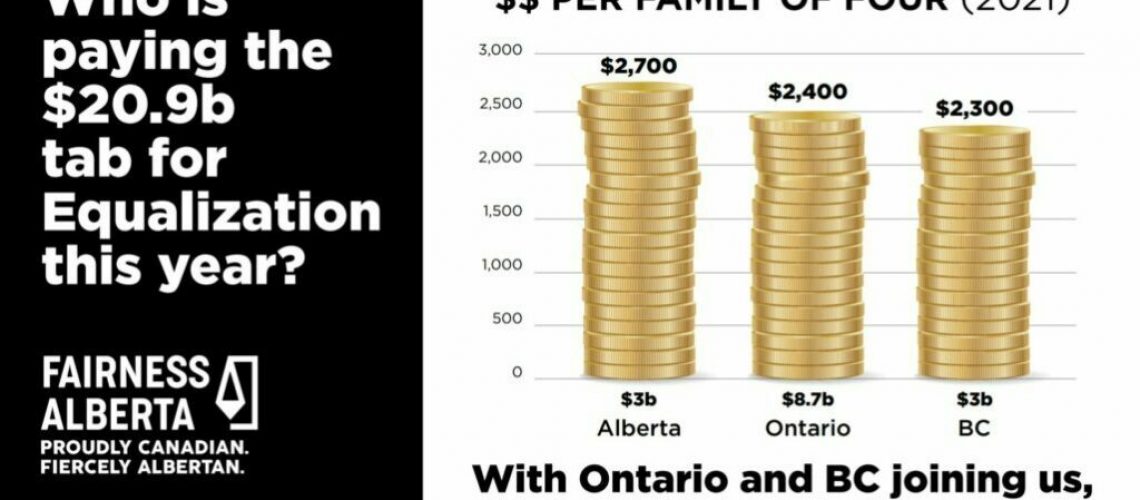EDMONTON, AB, OCTOBER 26, 2021 – With the YES side winning 61.7% of the vote in the Equalization Referendum, Fairness Alberta commended Albertans for elevating the cause of fiscal reforms in Canada – particularly with the flawed and unfair Equalization program.
“This referendum offered Albertans the chance to take a hard look at the unfair fiscal flows in the federation, particularly the deeply flawed Equalization program,” said Fairness Alberta Executive Director Dr. Bill Bewick. “Albertans’ YES vote elevates this issue in a way the federal government and other provinces can’t ignore, but the hard work in building national support for reforms begins now.”
Fairness Alberta developed an informative website at www.equalizationreferendum.ca to explain succinctly why the the Equalization program is Unfair, Unaffordable, and Unnecessary. Highlights include payments growing from $16-21 billion since 2015 while the provinces’ wealth gap rapidly narrowed, flaws in the formula like Hydro and ignoring costs of services that vastly underrepresent Quebec’s capacity, and roughly $600 per person from Albertans, Ontarians, and B.C. going straight to other provincial governments while their own struggle do deliver equal services.
“Equalization unfairness is hardly just an Alberta problem – families in Ontario, B.C., Saskatchewan, and Newfoundland are sending far too much in federal taxes so a bloated and unfair Equalization program can boost provincial services for only 30% of the country,” said Dr. Bewick. “We need to use this referendum to get the ball rolling on serious reforms that will make things more fair at a difficult time for the 70% of Canadians in contributing provinces.”
Dr. Bewick had the opportunity to explain what Alberta’s Equalization Referendum can mean for the rest of Canada in numerous media appearances over the last few weeks, including interviews with CBC’s Power and Politics and the National Post, a “Vote Yes” column in the Edmonton Sun, and a widely publicized debate at Mount Royal University with Dr. Trevor Tombe.
Fairness Alberta is a grassroots, non-partisan, and non-separatist association of concerned citizens, aiming to increase awareness across the country related to Albertans’ major contributions to Canada, while also providing clear, factual information on unfair federal policies that are anticipated to undermine the prosperity of Alberta and other contributing provinces further.
Dr. Bewick has emerged as a leading commentator on equalization reform, with columns in the National Post (February and August), Financial Post (May) and Calgary Herald (July ‘20 and June), as well as praise from commentators like Dr. Trevor Tombe for offering “thoughtful counterargument” in this critique of Tombe’s own analysis at www.thehub.ca.
Fairness Alberta’s previous releases, interviews, columns, and presentations to the House of Commons Standing Committee on Finance can be found in the NEWS section of our website. For more information on Fairness Alberta, its mandate, and future plans, please visit our website at www.fairnessalberta.ca.
For further information or to arrange interviews, please contact:
Bill Bewick, Ph.D.
Executive Director
Fairness Alberta
Cell: (780) 996-6019
Email: [email protected]
Background – Cost to BC / Ontarians
Fairness Alberta used the most recent Library of Parliament breakdown of federal revenues by province to estimate the share of Equalization funding that comes from taxpayers in each province based on their share of federal revenues, and broke it down to a per capita basis.

Alberta families are contributing about $2,700 to cover this year’s record Equalization payments, and Ontario and B.C. families are on the hook for about $2,400 each at a time when every provincial government is under tremendous strain. Fairness Alberta recently called for a rebate to contributing provinces until a new formula is worked out or Equalization is scrapped altogether.
Using the contribution rates to federal revenues by province last updated here we broke down Equalization funding per capita as follows:

